Charge State Effect of High Energy Ions on Material Modification in the Electronic Stopping Region
Abstract
:1. Introduction
2. Analytical Model
3. Results and Discussion
3.1. Lattice Disordering of WO3
3.2. Electronic Sputtering of WO3
3.3. Electronic Sputtering of LiF
3.4. Electronic Sputtering of SiO2, UO2 and UF4
3.5. Surface Morphology Modification: Poly-Methyl-Methacrylate (PMMA), Mica and Tetrahedral Amorphous Carbon (ta-C)
4. Discussion
5. Conclusions
Author Contributions
Funding
Data Availability Statement
Conflicts of Interest
References
- Ziegler, J.F.; Biersack, J.P.; Littmark, U. The Stopping and Range of Ions in Solids; Pergamon Press: New York, NY, USA, 1985; pp. 1–321. [Google Scholar]
- Tolstikhina, I.; Imai, M.; Winckler, N.; Shevelko, V. Basic Atomic Interactions of Accelerated Heavy Ions in Matter; Springer: Cham, Switzerland, 2018; pp. 1–220. [Google Scholar]
- Young, D.A. Etching of Radiation Damage in Lithium Fluoride. Nature 1958, 182, 375–377. [Google Scholar] [CrossRef]
- Silk, E.C.H.; Barnes, R.S. Examination of Fission Fragment Tracks with an Electron Microscope. Phil. Mag. 1959, 4, 970–972. [Google Scholar] [CrossRef]
- Fleischer, R.L.; Price, P.B.; Walker, R.M. Ion Explosion Spike Mechanism for Formation of Charged-Particle Tracks in Solids. J. Appl. Phys. 1965, 36, 3645–3652. [Google Scholar] [CrossRef]
- Fleischer, R.L. Tracks to Innovation; Springer: New York, NY, USA, 1998; pp. 1–193. [Google Scholar]
- Toulemonde, M.; Bouffard, S.; Studer, F. Swift heavy ions in insulating and conducting oxides: Tracks and physical properties. Nucl. Instr. Meth. B 1994, 91, 108–123. [Google Scholar] [CrossRef]
- Kamarou, A.; Wesch, W.; Wendler, E.; Undisz, A.; Rettenmayr, M. Swift heavy ion irradiation of InP: Thermal spike modeling of track formation. Phys. Rev. B 2006, 73, 184107. [Google Scholar] [CrossRef]
- Nakajima, K.; Morita, Y.; Suzuki, M.; Narumi, K.; Saitoh, Y.; Ishikawa, N.; Hojou, K.; Tsujimoto, M.; Isoda, S.; Kimura, K. Direct observation of fine structure in ion tracks in amorphous Si3N4 by TEM. Nucl. Instr. Meth. B 2012, 291, 12–16. [Google Scholar] [CrossRef] [Green Version]
- Papaleo, R.M.; Silva, M.R.; Leal, R.; Grande, P.L.; Roth, M.; Schattat, B.; Schiwietz, G. Direct Evidence for Projectile Charge-State Dependent Crater Formation Due to Fast Ions. Phys. Rev. Lett. 2008, 101, 167601. [Google Scholar] [CrossRef] [PubMed] [Green Version]
- Gupta, S.; Gehrke, H.G.; Krauser, J.; Trautmann, C.; Severin, D.; Bender, M.; Rothard, H.; Hofsass, H. Conducting ion tracks generated by charge-selected swift heavy ions. Nucl. Instr. Meth. B 2016, 381, 76–83. [Google Scholar] [CrossRef]
- Alencar, I.; Silva, M.R.; Leal, R.; Grande, P.L.; Papaleo, R.M. Impact Features Induced by Single Fast Ions of Different Charge- State on Muscovite Mica. Atoms 2021, 9, 17. [Google Scholar] [CrossRef]
- Rogers, M.D. Mass Transport and Grain Growth induced by Fission Fragments in Thin Films of Uranium Dioxide. J. Nucl. Mater. 1965, 16, 298–305. [Google Scholar] [CrossRef]
- Rogers, M.D. Ejection of Uranium Atoms from Sintered UO. J. Nucl. Mater. 1967, 22, 103–105. [Google Scholar] [CrossRef]
- Nilsson, G. Ejection Uranium Atoms from Sintered UO2 by Fission Fragments in Different Gases and at Different Gas Pressure. J. Nucl. Mater. 1966, 20, 215–230. [Google Scholar] [CrossRef]
- Bouffard, S.; Duraud, J.P.; Mosbah, M.; Schlutig, S. Angular distribution of the sputtered atoms from UO2 under high electronic stopping power irradiation. Nucl. Instr. Meth. B 1998, 141, 372–377. [Google Scholar] [CrossRef]
- Schlutig, S. Contribution a l’etude de la Pulverisation et de l’endommagement du Dioxyde d’uranuim par les Ions Lourds Rapides. Ph.D. Thesis, University of CAEN, Caen, France, 2001. [Google Scholar]
- Meins, C.K.; Griffith, J.E.; Qiu, Y.; Mendenhall, M.H.; Seiberling, L.E.; Tombrello, T.A. Sputtering of UF4 by High Energy Heavy Ions. Rad Eff. 1983, 71, 13–33. [Google Scholar] [CrossRef]
- Brown, W.L.; Lanzerotti, L.J.; Poate, J.M.; Augustyniak, W.M. “Sputtering” of Ice by MeV Light Ions. Phys. Rev. Lett. 1978, 40, 1027–1030. [Google Scholar] [CrossRef]
- Brown, W.L.; Augustyniak, W.M.; Brody, E.; Cooper, B.; Lanzerotti, L.J.; Ramirez, A.; Evatt, R.; Johnson, R.E. Energy Dependence of the Erosion of H2O Ice Films by H and He Ions. Nucl. Instr. Meth. 1980, 170, 321–325. [Google Scholar] [CrossRef]
- Bottiger, J.; Davies, J.A.; L’Ecuyer, J.; Matsunami, N.; Ollerhead, R. Erosion of Frozen-Gas Films by MeV Ions. Rad Eff. 1980, 49, 119–124. [Google Scholar] [CrossRef]
- Baragiola, R.A.; Vidal, R.A.; Svendsen, W.; Schou, J.; Shi, M.; Bahr, D.A.; Atteberrry, C.L. Sputtering of water ice. Nucl. Instr. Meth. B 2003, 209, 294–303. [Google Scholar] [CrossRef]
- Brown, W.L.; Lanzerotti, L.J.; Marcantonio, K.J.; Johnson, R.E.; Reimann, C.T. Sputtering of Ices by High Energy Particle Impact. Nucl. Instr. Meth. B 1986, 14, 392–402. [Google Scholar] [CrossRef]
- Dartois, E.; Auge, B.; Boduch, P.; Brunetto, R.; Chabot, M.; Domaracka, A.; Ding, J.J.; Kamalou, O.; Lv, X.Y.; Rothard, H.; et al. Heavy ion irradiation of crystalline water ice: Cosmic ray amorphisation cross-section and sputtering yield. Astron. Astrophys. 2015, 576, A125. [Google Scholar] [CrossRef] [Green Version]
- Galli, A.; Vorburger, A.; Wurz, P.; Tulej, M. Sputtering of water ice films: A re-assessment with singly and doubly charged oxygen and argon ions, molecular oxygen, and electrons. Icarus 2017, 291, 36–45. [Google Scholar] [CrossRef] [Green Version]
- Mejia, C.; Bender, M.; Severin, D.; Trautmann, C.; Boduch, P.; Bordalo, V.; Domaracka, A.; Lv, X.Y.; Martinez, R.; Rothard, H. Radiolysis and sputtering of carbon dioxide ice induced by swift Ti, Ni and Xe ions. Nucl. Instr. Meth. B 2015, 365, 477–481. [Google Scholar] [CrossRef]
- Griffith, J.E.; Weller, R.A.; Seiberling, L.E.; Tombrello, T.A. Sputtering of Uranium Tetrafluoride in the Electronic Stopping Region. Rad Eff. 1980, 51, 223–232. [Google Scholar] [CrossRef]
- Toulemonde, M.; Assmann, W.; Muller, D.; Trautmann, C. Electronic sputtering of LiF, CaF2, LaF3 and UF4 with 197 MeV Au ions: Is the stoichiometry of atom emission preserved? Nucl. Instr. Meth. B 2017, 406, 501–506. [Google Scholar] [CrossRef]
- Qiu, Y.; Griffith, J.E.; Meng, W.J.; Tombrello, T.A. Sputtering of Silicon and its Compounds in the Electronic Stopping Region. Rad Eff. 1983, 70, 231–236. [Google Scholar] [CrossRef]
- Sugden, S.; Sofield, C.J.; Murrell, M.P. Sputtering by MeV ions. Nucl. Instr. Meth. B 1992, 67, 569–573. [Google Scholar] [CrossRef]
- Matsunami, N.; Sataka, M.; Iwase, A. Electronic sputtering of oxides by high energy heavy ion impact. Nucl. Instr. Meth. B 2002, 193, 830–834. [Google Scholar] [CrossRef]
- Arnoldbik, W.M.; Tomozeiu, N.; Habraken, F.H.P.M. Electronic sputtering of thin SiO2 films by MeV heavy ions. Nucl. Instr. Meth. B 2003, 203, 151–157. [Google Scholar] [CrossRef]
- Matsunami, N.; Fukuoka, O.; Shimura, T.; Sataka, M.; Okayasu, S. A multi-exciton model for the electronic sputtering of oxides. Nucl. Instr. Meth. B 2005, 230, 507–511. [Google Scholar] [CrossRef]
- Toulemonde, M.; Assmann, W.; Trautmann, C. Electronic sputtering of vitreous SiO2: Experimental and modeling results. Nucl. Instr. Meth B 2016, 379, 2–8. [Google Scholar] [CrossRef]
- Toulemonde, M.; Assmann, W.; Trautmann, C.; Gruner, F. Jetlike Component in Sputtering of LiF Induced by Swift Heavy Ions. Phys. Rev. Lett. 2002, 88, 057602. [Google Scholar] [CrossRef]
- Assmann, W.; d’Etat, B.B.; Bender, M.; Boduch, P.; Grande, P.L.; Lebius, H.; Lelievre, D.; Marmitt, G.G.; Rothard, H.; Seidl, T.; et al. Charge-state related effects in sputtering of LiF by swift heavy ions. Nucl. Instr. Meth B 2017, 392, 94–101. [Google Scholar] [CrossRef]
- Matsunami, N.; Okayasu, S.; Sataka, M.; Tsuchiya, B. Electronic sputtering of SiC and KBr by high energy ions. Nucl. Instr. Meth. B 2020, 478, 80–84. [Google Scholar] [CrossRef]
- Matsunami, N.; Sataka, M.; Okayasu, S.; Tazawa, M. Electronic sputtering of nitrides by high-energy ions. Nucl. Instr. Meth. B 2007, 256, 333–336. [Google Scholar] [CrossRef]
- Matsunami, N.; Kakiuchida, H.; Tazawa, M.; Sataka, M.; Sugai, H.; Okayasu, S. Electronic and atomic structure modifications of copper nitride films by ion impact and phase separation. Nucl. Instr. Meth. B 2009, 267, 2653–2656. [Google Scholar] [CrossRef]
- Matsunami, N.; Sataka, M.; Iwase, A.; Okayasu, S. Electronic excitation induced sputtering of insulating and semiconducting oxides by high energy heavy ions. Nucl. Instr. Meth. B 2003, 209, 288–293. [Google Scholar] [CrossRef]
- Matsunami, N.; Sataka, M.; Okayasu, S.; Ishikawa, N.; Tazawa, M.; Kakiuchida, H. High-energy ion irradiation effects on atomic structures and optical properties of copper oxide and electronic sputtering. Nucl. Instr. Meth. B 2008, 266, 2986–2989. [Google Scholar] [CrossRef]
- Matsunami, N.; Sakuma, Y.; Sataka, M.; Okayasu, S.; Kakiuchida, H. Electronic sputtering of CuO films by high-energy ions. Nucl. Instr. Meth. B 2013, 314, 55–58. [Google Scholar] [CrossRef]
- Matsunami, N.; Sataka, M.; Okayasu, S.; Kakiuchida, H. Ion irradiation effects on tungsten-oxide films and charge state effect on electronic erosion. Nucl. Instr. Meth. B 2010, 268, 3167–3170. [Google Scholar] [CrossRef]
- Matsunami, N.; Okayasu, S.; Sataka, M. Electronic excitation effects on Fe2O3 films by high-energy ions. Nucl. Instr. Meth. B 2018, 435, 142–145. [Google Scholar] [CrossRef]
- Sigmund, P. Sputtering by Ion Bombardment: Theoretical Concepts. Chapter 2. In Sputtering by Particle Bombardment; Behrisch, R., Ed.; Springer: Berlin, Germany, 1981; Volume 1, pp. 9–71. [Google Scholar]
- Matsunami, N.; Sataka, M.; Iwase, A. Sputtering of high Tc superconductor YBa2Cu3O7-δ by high energy heavy ions. Nucl. Instr. Meth. B 2001, 175–177, 56–61. [Google Scholar] [CrossRef]
- Meftah, A.; Assmann, W.; Khalfaoui, N.; Stoquert, J.P.; Studer, F.; Toulemonde, M.; Trautmann, C.; Voss, K.-O. Electronic sputtering of Gd3Ga5O12 and Y3Fe5O12 garnets: Yield, stoichiometry and comparison to track formation. Nucl. Instr. Meth. B 2011, 269, 955–958. [Google Scholar] [CrossRef]
- Matsunami, N.; Sataka, M.; Okayasu, S.; Tsuchiya, B. Modification of SiO2, ZnO, Fe2O3 and TiN Films by Electronic Excitation under High Energy Ion Impact. QuBS 2021, in press. [Google Scholar]
- Matsunami, N.; Kato, M.; Sataka, M.; Okayasu, S. Disordering of ultra thin WO3 films by high-energy ions. Nucl. Instr. Meth. B 2017, 409, 272–276. [Google Scholar] [CrossRef]
- Jain, I.P.; Agarwal, G. Ion beam induced surface and interface engineering. Surf. Sci. Rep. 2011, 66, 77–172. [Google Scholar] [CrossRef]
- Aumayr, F.; Winter, H. Potential sputtering. Phil. Trans. R. Soc. Lond. A 2004, 362, 77–102. [Google Scholar] [CrossRef] [PubMed]
- Lake, R.E.; Pomeroy, J.M.; Grube, H.; Sosolik, C.E. Charge State Dependent Energy Deposition by Ion Impact. Phys. Rev. Lett. 2011, 107, 063202. [Google Scholar] [CrossRef] [Green Version]
- Komarov, F.F. Nano- and microstructuring of solids by swift heavy ions. Phys. Uspekhi 2017, 60, 435–471. [Google Scholar] [CrossRef]
- Zeng, J.; Liu, J.; Yao, H.J.; Zhai, P.F.; Zhang, S.X.; Guo, H.; Hu, P.P.; Duan, J.L.; Mo, D.; Hou, M.D.; et al. Comparative study of irradiation effects in graphite and graphene induced by swift heavy ions and highly charged ions. Carbon 2016, 100, 16–26. [Google Scholar] [CrossRef] [Green Version]
- Grande, P.L.; Schiwietz, G. Convolution approximation for the energy loss, ionization probability and straggling of fast ions. Nucl. Instr. Meth. B 2009, 267, 859–865. [Google Scholar] [CrossRef] [Green Version]
- Ziegler, J.F.; Ziegler, M.D.; Biersack, J.P. SRIM-The stopping and range of ions in matter (2010). Nucl. Instr. Meth. B 2010, 268, 1818–1823. [Google Scholar] [CrossRef] [Green Version]
- Wittkower, A.B.; Betz, H.D. Equilibrium-Charge-State Distributions of Energetic Ions (Z > 2) in Gaseous and Solid Media. At. Data 1973, 5, 113–166. [Google Scholar] [CrossRef]
- Shima, K.; Kuno, N.; Yamanouchi, M.; Tawara, H. Equilibrium Charge Fractions of Ions of Z = 4–92 Emerging From A Carbon Foil. At. Data Nucl. Data Tables 1992, 51, 173–241. [Google Scholar] [CrossRef]
- Schiwietz, G.; Grande, P.L. Improved charge-state formulas. Nucl. Instr. Meth B 2001, 175–177, 125–131. [Google Scholar] [CrossRef]
- Imai, M.; Sataka, M.; Kawatsura, K.; Takahiro, K.; Komaki, K.; Shibata, H.; Sugai, H.; Nishio, K. Equilibrium and non-equilibrium charge-state distributions of 2 MeV/u sulfur ions passing through carbon foils. Nucl. Instr. Meth B 2009, 267, 2675–2679. [Google Scholar] [CrossRef]
- Imai, M.; Sataka, M.; Matsuda, M.; Okayasu, S.; Kawatsura, K.; Takahiro, K.; Komaki, K.; Shibata, H.; Nishio, K. Equilibrium and non-equilibrium charge-state distributions of 2 MeV/u carbon ions passing through carbon foils. Nucl. Instr. Meth B 2015, 354, 172–176. [Google Scholar] [CrossRef]
- Shevelko, V.P.; Litsarev, M.S.; Song, M.-Y.; Tawara, H.; Yoon, J.-S. Electron loss of fast many-electron ions colliding with neutral atoms: Possible scaling rules for the total cross sections. J. Phys. B 2009, 42, 065202. [Google Scholar] [CrossRef]
- DuBois, R.D.; Santos, A.C.F.; Olson, R.E. Scaling laws for electron loss from ion beams. Nucl. Instr. Meth. A 2005, 544, 497–501. [Google Scholar] [CrossRef]
- DuBois, R.D.; Santos, A.C.F. Target-Scaling Properties for Electron Loss by Fast Heavy Ions. In Atomic Processes in Basic and Applied Physics; Shevelko, V., Tawara, H., Eds.; Springer: Berlin, Germany, 2012; pp. 185–209. [Google Scholar]
- Lide, D.R. (Ed.) CRC Handbook of Chemistry and Physics, 84th ed.; CRC Press: Boca Raton, FL, USA, 2003. [Google Scholar]
- Bohr, N. The Penetration of Atomic Particles through Matter. Dan. Vid. Selsk. Mat. Fys. Medd. 1948, 18, 1–144. [Google Scholar]
- Rodrigues, G.C.; Indelicato, P.; Santos, J.P.; Patte, P.; Parente, F. Systematic calculation of total atomic energies of ground state configurations. At. Data Nucl. Data Tables 2004, 86, 117–233. [Google Scholar] [CrossRef]
- Schlachter, A.S.; Stearns, J.W.; Graham, W.G.; Berkner, K.H.; Pyle, R.V.; Tanis, J.A. Electron capture for fast highly charged ions in gas targets: An empirical scaling rule. Phys. Rev. A 1983, 27, 3372–3374. [Google Scholar] [CrossRef] [Green Version]
- Matsunami, N.; Sataka, M.; Okayasu, S. Effective depth of electronic sputtering of WO3 films by high-energy ions. Nucl. Instr. Meht. B 2019, 460, 185–188. [Google Scholar] [CrossRef]
- Storm, E.; Israel, H.I. Photon Cross Sections from 1 keV to 100 MeV for Elements Z = 1 to Z. = 100. Nucl. Data Tables A 1970, 7, 565–681. [Google Scholar] [CrossRef]
- Blazevic, A.; Bohlen, H.G.; Oertzen, W.v. Stopping power of swift neon ions in dependence on the charge state in the non-equilibrium regime. Nucl. Instr. Meth. B 2002, 190, 64–68. [Google Scholar] [CrossRef]
- Miranda, J.; Pineda, J.C. Chemical effects in the stopping cross sections of protons in rare earth fluorides. Nucl. Instr. Meth. B 2007, 254, 39–42. [Google Scholar] [CrossRef]
- Biersack, J.P.; Fink, D.; Miekeley, W.; Tjan, K. 1–3 MeV Alpha and Triton Stopping Powers in LiF and Li Alloys. Nucl. Instr. Meth. B 1986, 15, 96–100. [Google Scholar] [CrossRef]
- Damache, S.; Moussa, D.; Ouichaoui, S. Stopping powers of LiF thin films deposited onto self-supporting Al foils for swift protons. Nucl. Instr. Meth. B 2013, 308, 46–53. [Google Scholar] [CrossRef]
- Assmann, W.; Toulemonde, M.; Trautmann, C. Electronic Sputtering with Swift Heavy Ions. In Sputtering by Particle Bombardment; Behrisch, R., Eckstein, W., Eds.; Springer: Berlin, Germany, 2007; pp. 401–451. [Google Scholar]
- Toulemonde, M.; Assmann, W.; Ban-d’Etat, B.; Bender, M.; Bergmaier, A.; Boduch, P.; Negra, S.D.; Duan, J.; El-Said, A.S.; Gruner, F.; et al. Sputtering of LiF and other halide crystals in the electronic energy loss regime. Eur. Phys. J. D 2020, 74, 144. [Google Scholar] [CrossRef]
- Itoh, N. Creation of lattice defects by electronic excitation in alkali halides. Adv. Phys. 1982, 31, 491–551. [Google Scholar] [CrossRef]
- Itoh, N.; Stoneham, A.M. Materials Modification by Electronic Excitation; Cambridge University Press: Cambridge, UK, 2001; pp. 1–520. [Google Scholar]

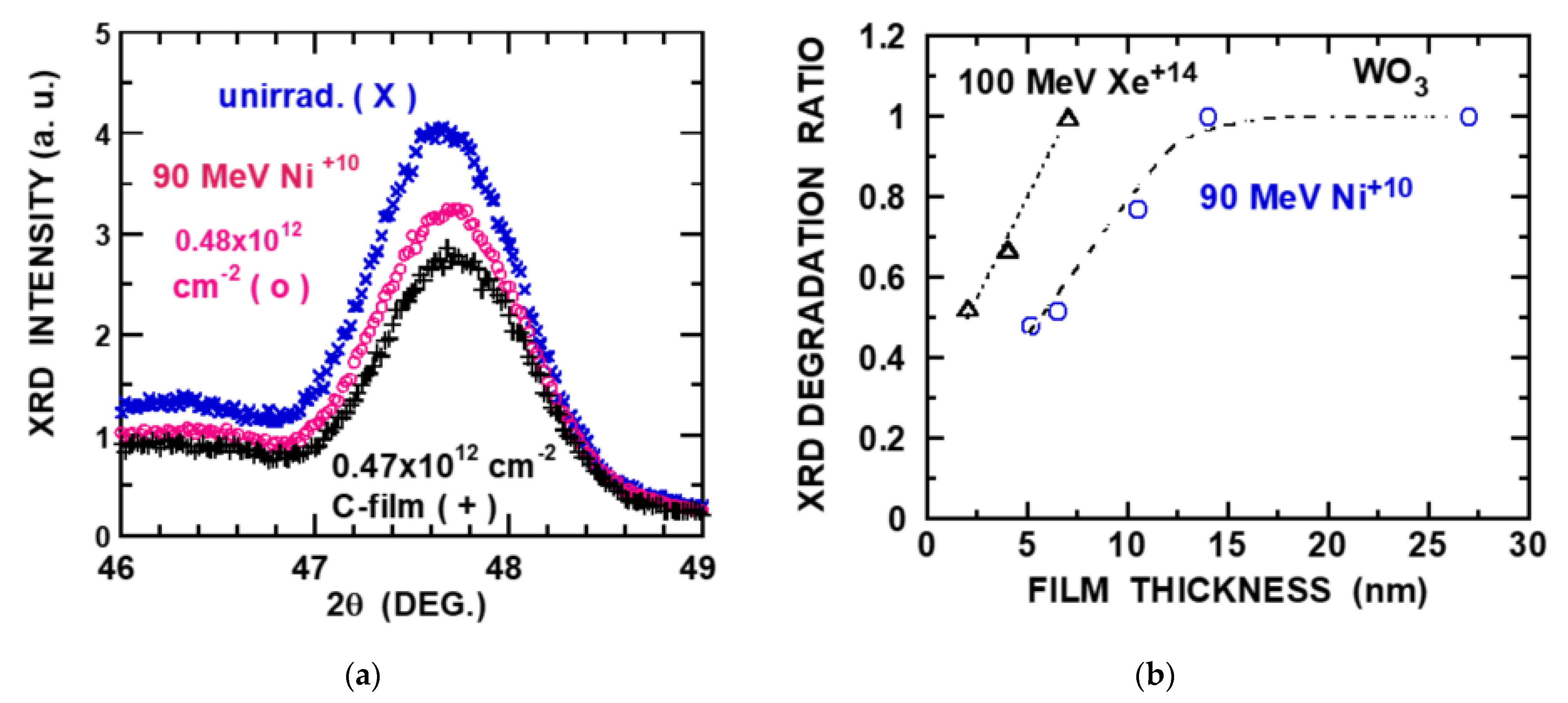


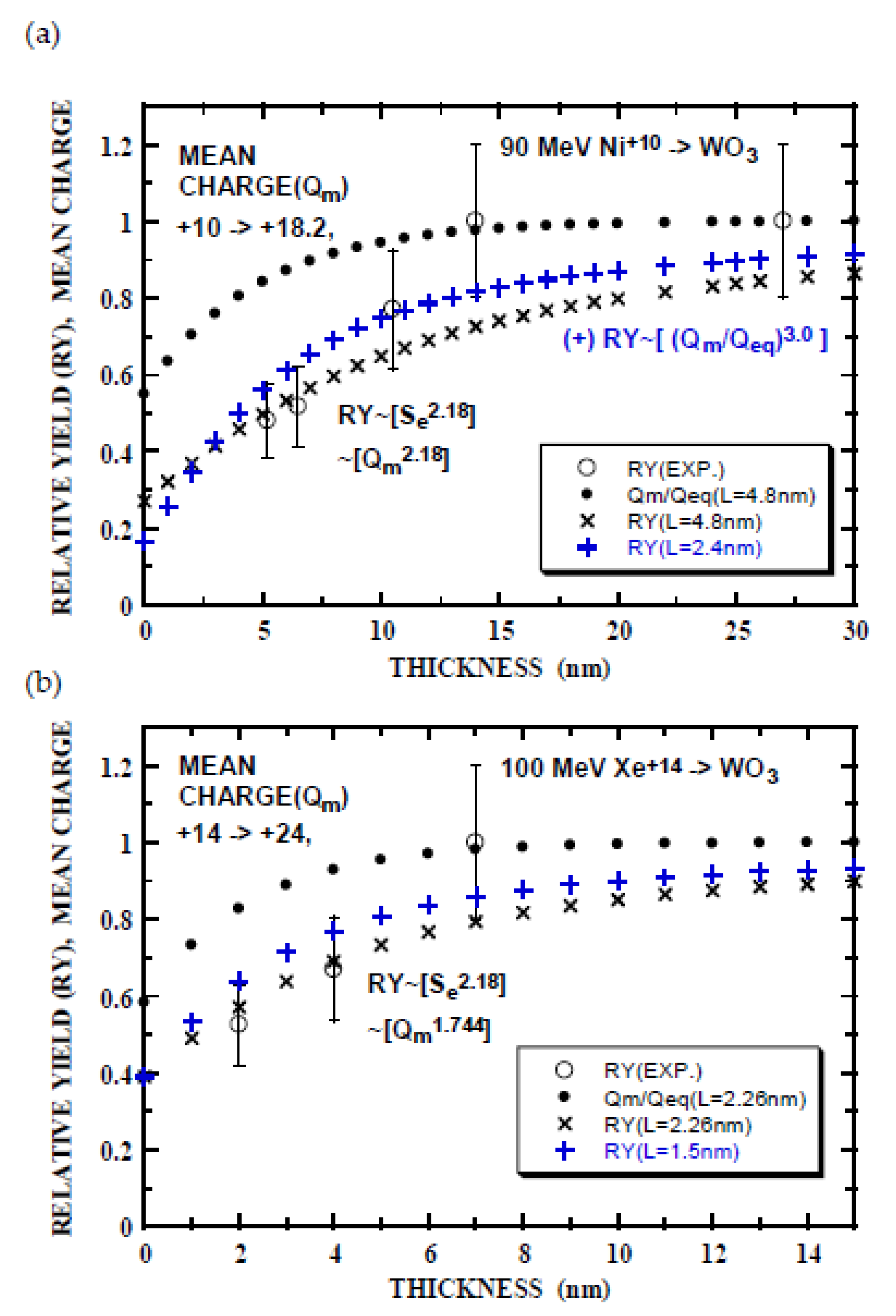

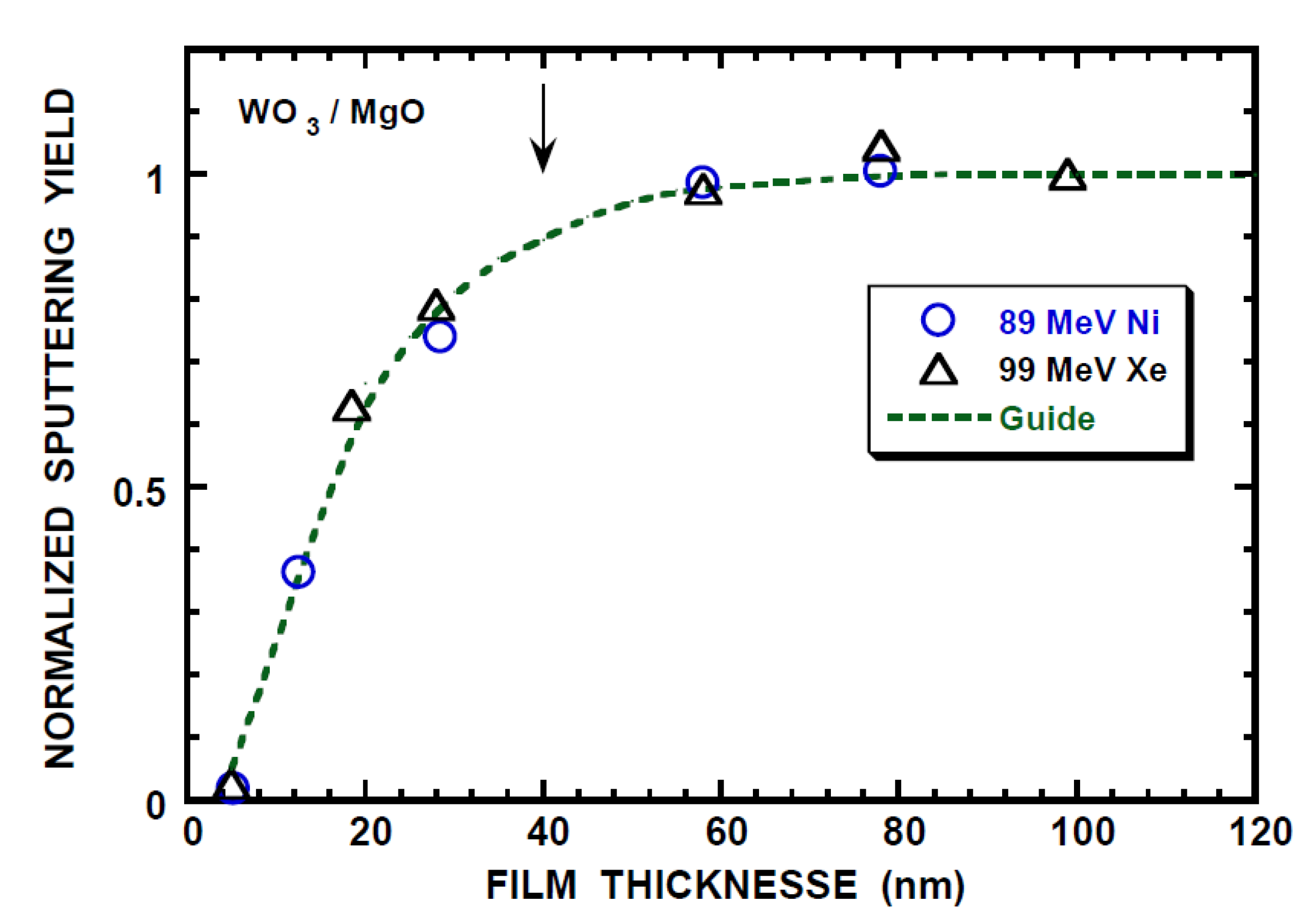
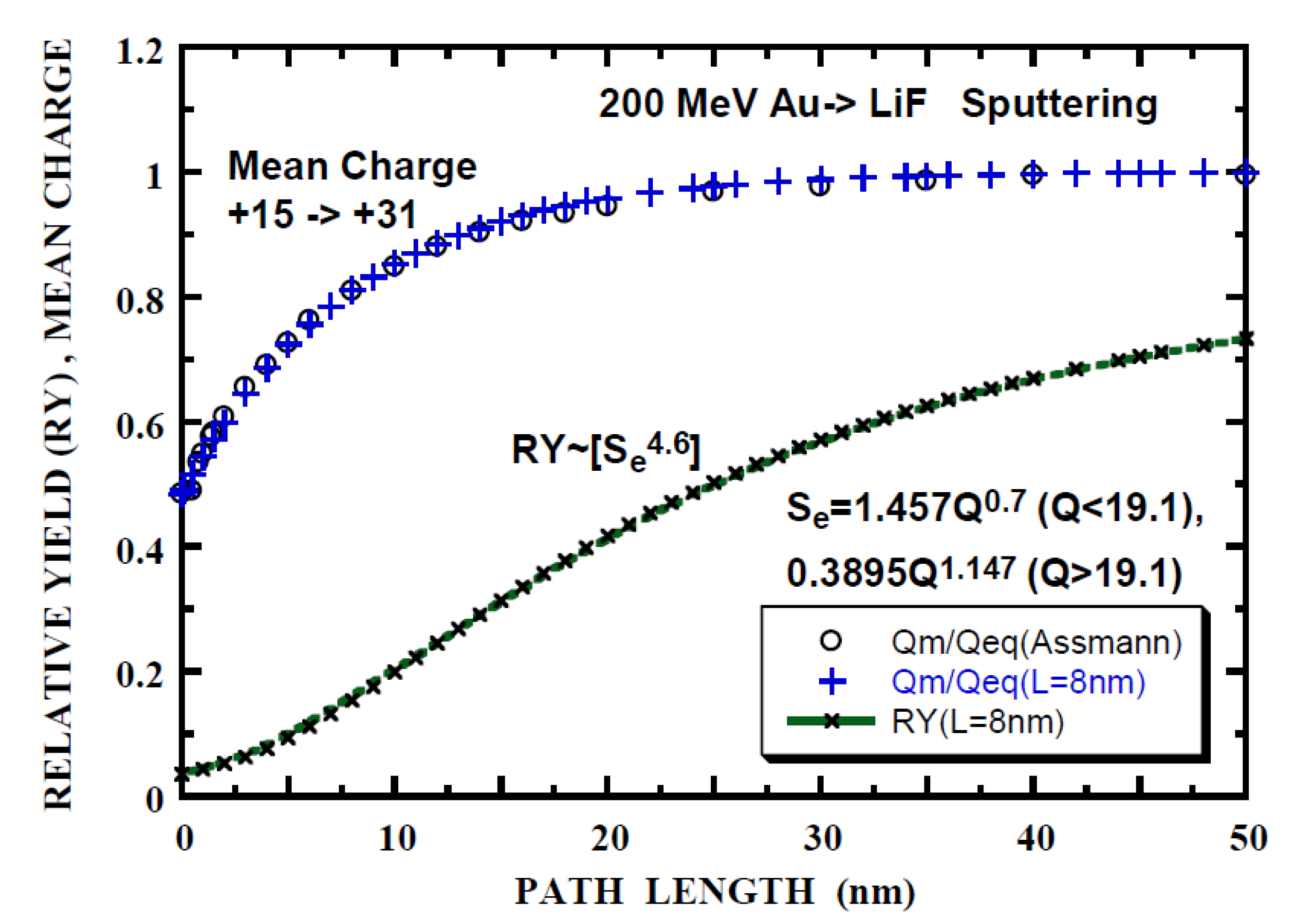
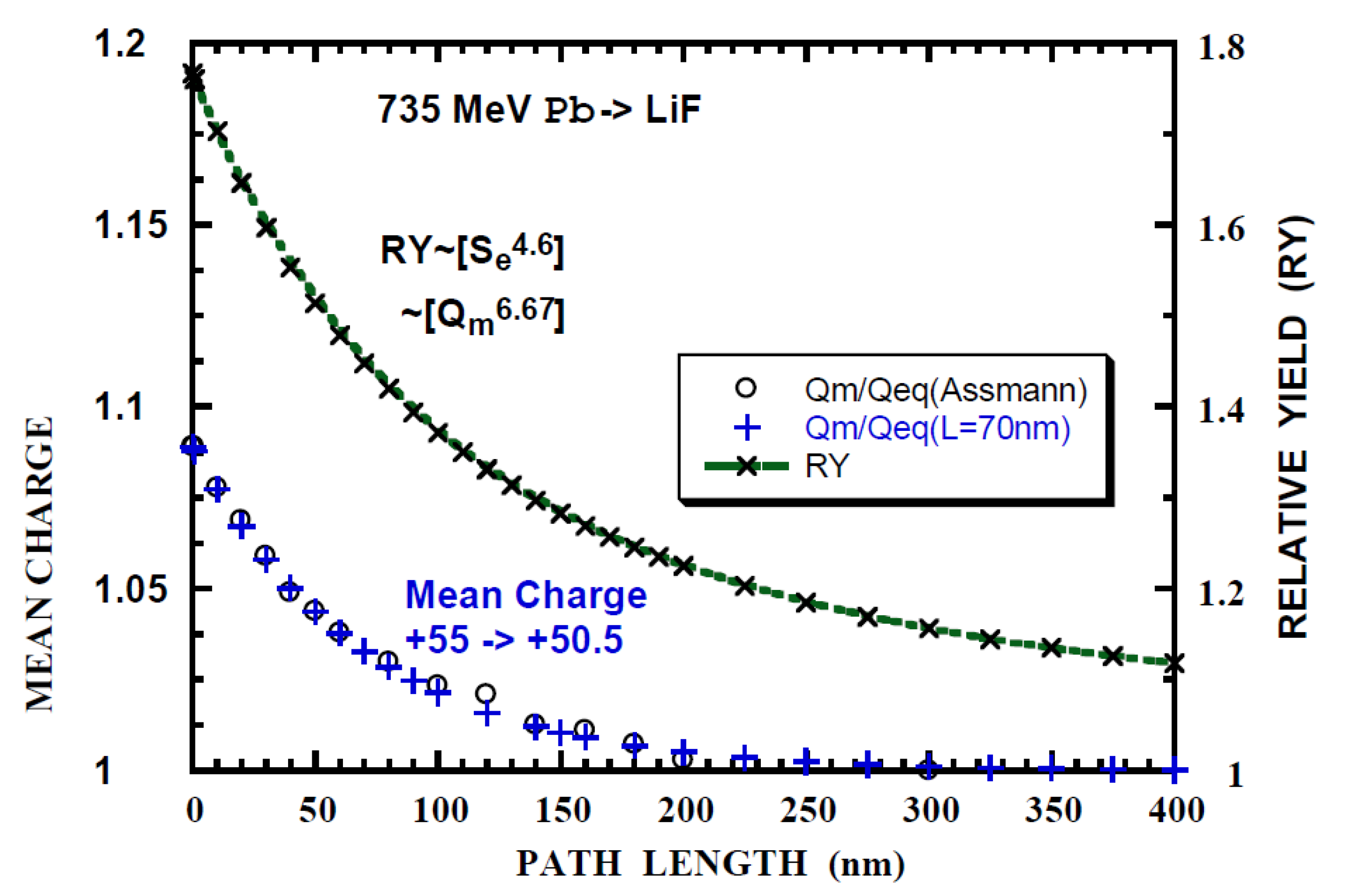
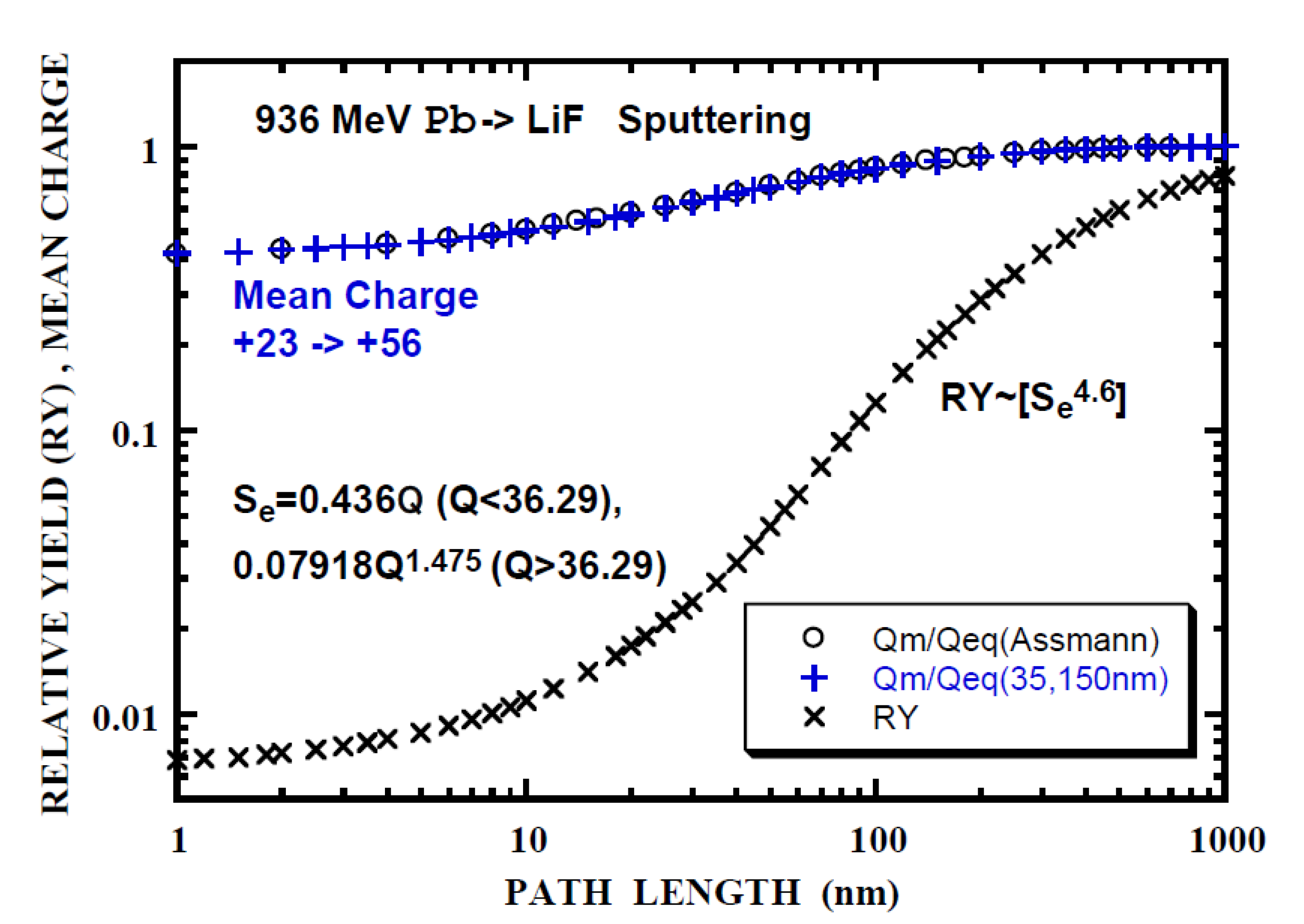
| Experiment (a) | Empirical (b) | Empirical (c) | Empirical (d) |
|---|---|---|---|
| 12.68 | 12.63 | 11.51 | 12.58 (11.63) |
| Q | IP (eV) | σLT 10−16cm2 | LT (nm) | Neff | σL1 10−16cm2 | Ls(nm) | σC 10−16cm2 |
|---|---|---|---|---|---|---|---|
| 7 | 328.75 | 0.505 | 2.0 | 7(2s22p5) | 0.114 | 8.7 | 0.029 |
| 10 | 504.8 | 0.344 | 2.9 | 4(2s22p2 ) | 0.058 | 17.3 | 0.072 |
| 12 | 652.2 | 0.253 | 4.0 | 2(2s2) | 0.033 | 30 | 0.11 |
| 13 | 707 | 0.226 | 4.4 | 1(2s1) | 0.0227 | 44 | 0.13 |
| Ion | E (MeV) | Qeq (a) | Qeq (b) | Qeq (c) | Qeq (d) | Se (e) | Se (f) (keV/nm) | Se (g) |
|---|---|---|---|---|---|---|---|---|
| 58Ni | 90 | 19 | 16.8 | 18.2(15.8) | 14.7 | 11.91 | 13.46 | 12.36 |
| 136Xe | 100 | 25 | 20.4 | 23.9(16.1) | 13.8 | 20.0 | 19.14 | 19.4 |
| 136Xe | 200 | 30 | 26 | 29.3(22.3) | 19.3 | 25.14 | 24.56 | 24.44 |
| 40Ar | 60 | 13 | 11.9 | 12.8(11.6) | 11.4 | 6.824 | 7.585 | 7.462 |
| Ion | E (MeV) | k |
|---|---|---|
| 58Ni | 90 | 1.0 (Q = 10–20) |
| 136Xe | 100 | 0.8 (Q = 14–25) |
| 136Xe | 200 | 0.84 (Q = 14–30) |
| 40Ar | 60 | 0.75 (Q = 6–14) |
| Q | IP (eV) | σLT W+O 10−16 cm2 | Neff | σL1 W 10−16 cm2 | σL1T (W+O) | Ls (nm) | σC 10−16 cm2 |
|---|---|---|---|---|---|---|---|
| (a) 90 MeV 58Ni | |||||||
| 10 | 321 | 18.7 | 8 (3s23p5) | 0.668 | 1.12 | 4.8 | 0.71 |
| 14 | 464 | 12.6 | 4 (3s23p2) | 0.337 | 0.567 | 9.4 | 1.34 |
| 17 | 607 | 8.73 | 1 (3s1) | 0.142 | 0.239 | 22.4 | 1.94 |
| 18 | 1541 | 1.1 | 8 (2s22p6) | 0.10 | 0.17 | 31.5 | 2.17 |
| (b) 100 MeV 136Xe | |||||||
| 14 | 343 | 20.0 | 12 (4s24p64d25s2) | 0.702 | 1.18 | 4.5 | 6.3 |
| 18 | 549 | 7.42 | 8 (4s24p6) | 0.332 | 0.557 | 9.6 | 10 |
| 20 | 616 | 5.5 | 6 (4s24p4) | 0.254 | 0.428 | 12.5 | 12 |
| 24 | 818 | 2.34 | 2 (4s2) | 0.112 | 0.189 | 28 | 16 |
| Ion | E (MeV) | θ1 | Qo, Qeq | Lps (nm) | RYISO | RYANI Lp(nm) | RYTO | Seo, Seq | Seq (a) | Seq (b) |
|---|---|---|---|---|---|---|---|---|---|---|
| 197Au | 200 | 20 | 15, 31 | 18 | 0.0815 4.3 | 0.923 (176) | 0.226 11.2 | 9.7, 20 | 21.2 | 22.7 |
| 197Au | 200 | 60 | 15, 31 | 0.44 21.2 | 1.0 | 0.608 33.2 | ||||
| 132I | 150 | 70 | 12, 25 | 19 | 0.44 18.9 | 1.06 | 0.631 31.2 | 7.3, 15 | 16.0 | 16.8 |
| 208Pb | 735 | 60 | 39, 51 | 170 | 0.41 73.1 | 0.64 174 | 0.507 109 | 20, 29 | 27.8 | 27.4 |
| 208Pb | 735 | 60 | 47, 51 | 180 | 0.695 41.3 | 1.17 | 0.894 290 | 26, 29 | ||
| 208Pb | 735 | 60 | 55, 51 | 200 | 1.715 8.0 | 1.666 16.4 | 1.69 12.2 | 33, 29 | ||
| 208Pb | 936 | 60 | 23, 56 | 300 | 0.0181 21 | 0.0312 37.2 | 0.024 29 | 10, 30 | 28.1 | 27.0 |
| Ion | E (MeV) | Qeq (a),(b),(c) | Se(Q) = BQK B, K (Q range) | L(Q Range) (nm) | σ 10−16cm2 |
|---|---|---|---|---|---|
| Au | 200 | 31, 34.7, 33 | 1.457, 0.7 (15–19.1) 0.3895, 1.147 (19.1–31) | 8 (15–31) | 0.204 |
| I | 150 | 25, 27.2, 28 | 1.33, 0.6855 (12–15.6) 0.3763, 1.145 (15.6–25) | 7 (12–15) | 0.233 |
| Pb | 735 | 51, 50.5, 50.5 | 0.098, 1.45 (39–55) | 60 (39–50.5) 75 (47–50.5) 70 (55–50.5) | 0.0272 0.218 0.0233 * |
| Pb | 936 | 56, 53.5, 54.5 | 0.436, 1.0 (23–36.29) 0.07918, 1.475 (36.29–56) | 35 & 150 (23–56) | 0.0204 |
| Q | IP (eV) | σLT Li+F 10−16cm2 | Neff | σL1 F 10−16cm2 | σL1T Li+F 10−16cm2 | σC Li+F 10−16cm2 |
|---|---|---|---|---|---|---|
| 200 MeV 197Au (Vp/Vo = 6.37, EKE = 552 eV) | ||||||
| 15 | 452 | 0.919 | 10 (4f10) | 0.12 | 0.177 | 1.70 |
| 31 | 945 | 0.173 | 12( 4d105s2) | 0.050 | 0.0747 | 6.82 |
| 150 MeV 132I (Vp/Vo = 6.74, EKE = 618 eV) | ||||||
| 12 | 279 | 1.40 | 5 (4d5) | 0.158 | 0.235 | 0.816 |
| 25 | 1397 | 0.048 | 10 (3d10) | 0.0284 | 0.0421 | 3.74 |
| 735 MeV 208Pb (Vp/Vo = 11.89, EKE = 1922 eV) | ||||||
| 39 | 1884 | 0.102 | 7 (4d7) | 0.0213 | 0.0316 | 0.693 |
| 47 | 2605 | 0.05 | 17 (3d104s24p5) | 0.020 | 0.0299 | 1.05 |
| 50.5 | 3000 | 0.0346 | 13.5 (3d104s24p1.5) | 0.015 | 0.0227 | 1.23 |
| 55 | 5555 | 0.0042 | 9 (3d9) | 0.0056 | 0.0083 | 1.48 |
| 936 MeV 208Pb (Vp/Vo = 13.42, EKE = 2448 eV) | ||||||
| 23 | 858 | 0.28 | 5 (4f5) | 0.0464 | 0.0687 | 0.114 |
| 40 | 1945 | 0.10 | 6 (4d6) | 0.0285 | 0.0422 | 0.316 |
| 54 | 5414 | 0.0081 | 10 (3d10) | 0.020 | 0.0294 | 0.401 |
| 56 | 5703 | 0.0068 | 8 (3d8) | 0.00557 | 0.00824 | 0.855 |
| Ion | E (MeV) | θ1 | Qo | Lps (nm) | RYISO, Lp (nm) | RYANI, Lp (nm) | RYTO, Lp (nm) |
|---|---|---|---|---|---|---|---|
| Au | 200 | 20 | 15 | 18 | 0.0815, 4.3 | 0.923,(176) | 0.226, 11.2 |
| Au | 200 | 60 | 15 | 0.44, 21.4 | 1.0, | 0.608, 33.2 | |
| I | 150 | 70 | 12 | 19 | 0.444, 18.9 | 1.06, | 0.631, 31.2 |
| Pb | 735 | 60 | 39 | 170 | 0.41, 73.1 | 0.64, 174 | 0.507, 109 |
| Pb | 735 | 60 | 47 | 180 | 0.695, 41.3 | 1.17, | 0.894, 290 |
| Pb | 735 | 60 | 55 | 200 | 1.715, 8.0 | 1.666, 16.4 | 1.69, 12.2 |
| Pb | 936 | 60 | 23 | 300 | 0.0181, 21 | 0.0312, 37.2 | 0.024, 29 |
Publisher’s Note: MDPI stays neutral with regard to jurisdictional claims in published maps and institutional affiliations. |
© 2021 by the authors. Licensee MDPI, Basel, Switzerland. This article is an open access article distributed under the terms and conditions of the Creative Commons Attribution (CC BY) license (https://creativecommons.org/licenses/by/4.0/).
Share and Cite
Matsunami, N.; Sataka, M.; Okayasu, S.; Tsuchiya, B. Charge State Effect of High Energy Ions on Material Modification in the Electronic Stopping Region. Atoms 2021, 9, 36. https://0-doi-org.brum.beds.ac.uk/10.3390/atoms9030036
Matsunami N, Sataka M, Okayasu S, Tsuchiya B. Charge State Effect of High Energy Ions on Material Modification in the Electronic Stopping Region. Atoms. 2021; 9(3):36. https://0-doi-org.brum.beds.ac.uk/10.3390/atoms9030036
Chicago/Turabian StyleMatsunami, Noriaki, Masao Sataka, Satoru Okayasu, and Bun Tsuchiya. 2021. "Charge State Effect of High Energy Ions on Material Modification in the Electronic Stopping Region" Atoms 9, no. 3: 36. https://0-doi-org.brum.beds.ac.uk/10.3390/atoms9030036





